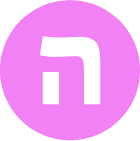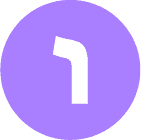-

CURRICULUM MAP
-

GAN AT A GLANCE
-

ALEF AT A GLANCE
-

BET AT A GLANCE
-

GIMEL AT A GLANCE
-

DALED AT A GLANCE
-

HEI AT A GLANCE
-

VAV AT A GLANCE
-

ZAYIN AT A GLANCE
|
Ivrit (Hebrew) |
Ritual |
Holidays |
Torah |
History, Culture & Community |
|
|---|---|---|---|---|---|
|
Gan I <3 Being Jewish |
Reading Readiness Hebrew Through Movement Modern: colors, numbers, shapes days of the week Core Prayers: Shema Modeh/ah Ani Shalom Aleichem Fri night blessings Four Questions |
When I do Jewish things at home or in synagogue I connect to the traditions of our people. |
The Jewish holidays are a 360° experience. When we use all five senses: taste, touch, smell, sight, and hearing to celebrate each holiday, we are able to get a richer sense of our Jewish Year! |
The Torah is a book that tells the story of the Jewish people. God is a character not only in the story, but one who also continues to act in our lives today as we encounter creation. |
I am a human being created “Betzelem Elohim” (in the divine image). I have a role to play in making the world a better place. |
|
Alef Concentric Circles of Being Jewish: Me, my Family, and my Community |
Letters & Vowels Hebrew Through Movement Modern: classroom objects, body parts, family members, students’ names Core Prayers: Mah Tovu Hinei Mah Tov Candle blessings Hadvallah (short) Shehechiyanu Four Questions |
Part of being a Jew is celebrating together with my family. Sacred objects help me to remember that every moment is special and holy whether it is a holiday or not. |
When we notice important moments and do something to honor them, we transform them into Special Jewish Times. Special Jewish Times can happen once a year (holidays), weekly (Shabbat), or even daily (waking up, eating, etc). |
The Torah is the story of the Jewish people, and as a Jewish person it is my story too! The Torah, its lessons, and its stories come alive for me when I can play in its narrative though drama, art, and other modalities of creative exploration. |
Jewish families come in many forms. You can find Jewish families all around the world. They may celebrate in different ways, but are still part of the same family – which we call K’lal Yisrael. |
|
Bet Jewish Rhythms of My Life |
Alef-Bet review and decoding Torah Yoga Modern: clothing family members sacred/ synagogue objects Core Prayers: Asher Yatzar Elohai Neshama Hashkiveinu Adon Olam Ein Keloheynu Chanukkah Blessings |
The synagogue is a special place where individual families come together to find a spiritual home. It is a place we pray, celebrate as a community, and learn. Even though all synagogues are different, they share certain characteristics and house particular Jewish ritual objects, including the Torah scroll. Our synagogue also helps tell the story of our particular Jewish community. |
The cycles of Jewish life and the calendar anchor and connect the Jewish people. Jews in different parts of the world may express their Judaism in different ways, but we all follow the same calendar and rhythms and share many customs and practices that tie us together as a people throughout time and space. |
People are not born mensches, they become mensches. When we look closely at the story of Joseph we watch him transform into a mensch, and think about the ways in which we can grow into mensches too. |
Living by Jewish values help us give meaning to our daily actions and relationships. When we give back to our community and engage in acts of tzedakah we are both performing a mitzvah and making the world (and ourselves) better! |
|
Gimel Mitzvot and Middot |
B’rachot (blessings) Hebrew Through Movement Modern: Names, animals, holiday & ritual vocabulary, and begin to learn grammar Sight word vocabulary of 30 words Core Prayers: Food blessings Short holiday blessings Kiddush for Shabbat eve Birkat haMazon (1st paragraph) V’achalta |
Mitzvot (commandments) are the building blocks of Jewish practice and one way that we show our love for God and for our community. When we do mitzvot, we are connecting to a larger community of Jews around the world (K’lal Yisrael). Mitzvot help us to see our lives through a Jewish lens, transforming everyday moments into opportunities to be thankful and to look at the bigger picture of the world around us. |
By observing the holidays each year, we are reminded of responsibilities and opportunities called mitzvot (commandments) that can guide and enrich our lives. Each Jewish holiday has its own customs and rituals and commemorates events in history. Each holiday reminds us of certain mitzvot. We are responsible for these mitzvot. |
The Torah tells the story of the Jewish people. After being freed from slavery in Egypt, the Torah describes how the Israelites wandered in the desert for 40 years. At a moment we recall as “Standing at Mount Sinai,” the Jews became a nation. Just as they entered into a covenant at “Sinai,” so too do we enter into that covenant in every generation by taking on the Mitzvot and behaving in ethical ways. |
Living by Jewish values help us give meaning to our daily actions and relationships. When we give back to our community and engage in acts of Tzedakah we are both performing a mitzvah and making the world (and ourselves) better! |
|
Daled Judaism – Past, Present and Future |
Shacharit and Ashrei Modern: Read a book in Hebrew – Yesh Lanu Llama Sight-word vocabulary of 50 words Core Prayers: Ashrei Barchu Yotzer Ahava Rabah Shema V’ahavta MiChamocha Avot V’Imahot G’vurot K’dushah Birchot Shalom |
From birth to death, Jewish tradition includes many ceremonies and rituals to mark transition points in our lives. Some of these ceremonies are old and some are newer. Some rituals have been relatively unchanged for centuries, and others continue to evolve today. |
Jews live in many countries all around the world. Though there are many similarities that bind us together, there are also many differences. By learning about the different ways Jews around the world celebrate the holidays, we are able to get a richer picture not only of the holidays themselves, but of the tapestry of the Jewish people and of ourselves. |
The Torah is a book that tells the story of the Jewish people. Learning about the Biblical family tree (in the book of B’reishit) can help us connect our Avot and Imahot to our contemporary families. |
Through the episodes in “The Mystery of the Coins”, we will explore Jewish history through the eyes of children living at various times and places through Jewish history. |
|
Hei Experiencing the Sacred: In Every Time & Place |
Torah Service and Haftara Trope Modern: Yesh Lanu Llama 2 Hebrew roots and sentence structure Core Prayers: Ein Kamocha Av Harachamim Ki Mitziyon Shema/ Gadlu L’cha Adonai 1st Haftarah blessing Y’halleilu Etz chayim Adon Olam |
Havayah: A Community Experience Along with their peers from congregations across Philadelphia, our 5th graders study the theme of “Sacred Space, Sacred Time” through a project-based approach. Learning is done both in the classroom and at mifgashim (meet-ups) with studnets from other synagogue schools. |
Collective Jewish memory has shaped the Jewish obligation to cherish and proclaim “liberty throughout the land” (Lev. 25:10). The history and liturgy of our Jewish holidays echoes this important value and gives us opportunities to put it into action. |
Tanakh is a compilation of the core and foundational texts of the Jewish people. It is made up of Torah, the books of the prophets, and the writings (Torah, nevi’im, ketuvim). Tanakh along with Talmud and Midrash are the basis of our textual tradition. |
Introduction to early American Jewish history with a focus on Philadelphia – from the Colonial period to 1880. We also study or own family stories. |
|
Vav Finding my Jewish Voice in the sea of our tradition |
Weekday Amidah and Torah Trope Modern: Og haRasha Core Prayers: Pieces of weekday Amidah Be Ana Rahetz Torah Blessings 2nd Haftarah blessing Mizmor l’David Aleynu Kaddish Shalom Alechem Full erev Shabbat Kiddush Birkat HaMazon |
Praying as a Jew means something different to everyone. As I prepare to become a Jewish adult, it is important to explore is what prayer can mean for me. This includes learning how different communities have understood prayer and how it functions at different points in history, the order and structure of the service, and various models for Jewish prayer. |
Learning the history of the Jewish holidays gives us a richer understanding of their context. As I prepare to become a Jewish adult, I have an opportunity to think about the ways in which I understand the commandments and Jewish observances of the holidays in my life. |
The Torah, its stories, parables, and legal texts provide a foundation for centuries of interpretation and commentary that are as central to Jewish tradition as the base text of Tanach. Halakha (Jewish law) is dynamic and ever-evolving, and takes place through an inter-generational discussion through text from the rabbinic period through our own time. |
The Holocaust is an historical event that is equally relevant within and outside of the Jewish community. In addition to being one of the darkest moments in all of human history (and certainly of Jewish history), it is also an example of what can happen when prejudice, racism, and hatred go unchecked in a community and becomes societally accepted. |
|
Zayin Stepping Up – Becoming a Jewish Adult Judaism is more than a religion; it is a People and a Civilization. |
Weekday morning service Core Prayers: Weekday nusach for the Amidah B’rachot for tallit and tefillin Birkat HaMazon Review: Adon Olam Ein Keloheinu Veshamru & Vayechulu Kiddush for Shabbat am |
Jewish community is framed by certain values that inform the way Jews live. Some of these seem identical to other human/ American values, but are Jewish as well because they are rooted in the texts and history of our people. I make choices about how to behave that are governed by my Jewish values. |
Holidays are a way to connect to: God/ spirituality, Community, Jewish tradition, Peoplehood/ history. |
Pirke Avot is one of our oldest ethical Jewish texts. It gives us a link to how the ancient rabbis understood human nature and establishes a foundation for how we build community today. |
By learning about our history as American Jews, we gain an appreciation for where we have come from, and how to shape where we hope to go. |
